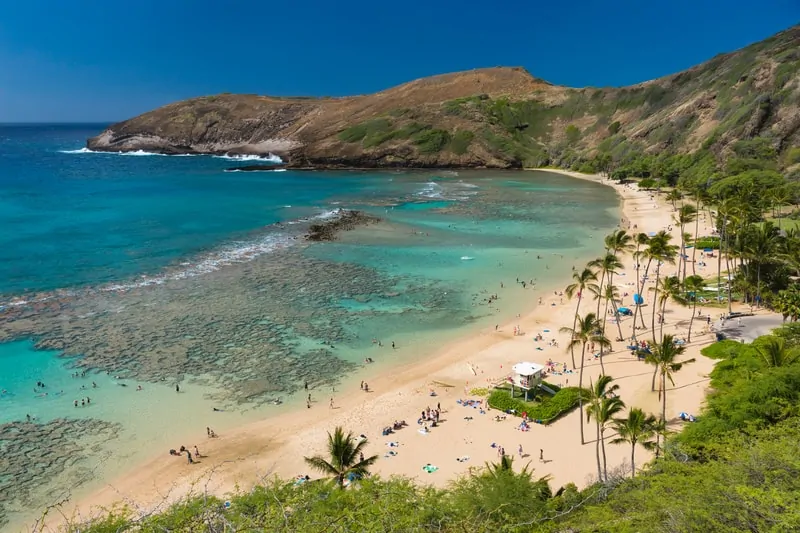
This article is part of our guide for snorkeling on Oahu.
Hanauma Bay is located on the east (well, south-east) side of the island Oahu, Hawaii. It’s an old volcanic crater protected from the rough ocean. As a result, it’s a popular place for people to snorkel in calm shallow waters, white sand, and over 400 species of fish. This diverse marine life is one of the reasons why I added this bay to my “best snorkel locations in the world“.
In 1967, Hanauma Bay became a protected marine life conservation area. Today, in an effort to protect the ecosystem, they only allow 3,000 visitors per day. Visitors need to arrive early as parking is limited. Some people gained access in the afternoon, but you need to be lucky and catch a quiet day for that.
How to get there
Daniel K. Inouye International Airport (aka. Honolulu International Airport) is the main airport on Oahu, located in the south of the island. From there you could either hire a car, grab a taxi or use public transportation.
About Hanauma Bay
Hanauma Bay is shaped like a horseshoe on the eastern side of the island Oahu. It’s actually an old collapsed volcanic crater. The beaches are made of white sand, the water is incredibly blue and it’s extremely popular among snorkelers.
There’s a coral reef that protects the bay. The reef is only a few feet under water, which makes it easy to observe the marine life. The water is clear and cool, fish are literally everywhere, as well as other sea life including sea turtles. Some people prefer to wear a snorkel rash guard as an extra layer of protection against some rocky surfaces. Make sure to always watch where you’re standing. Even though we’re not supposed to step on any coral, there could be some rocks on the ocean floor. Water shoes for snorkeling could be a luxury to take with you.
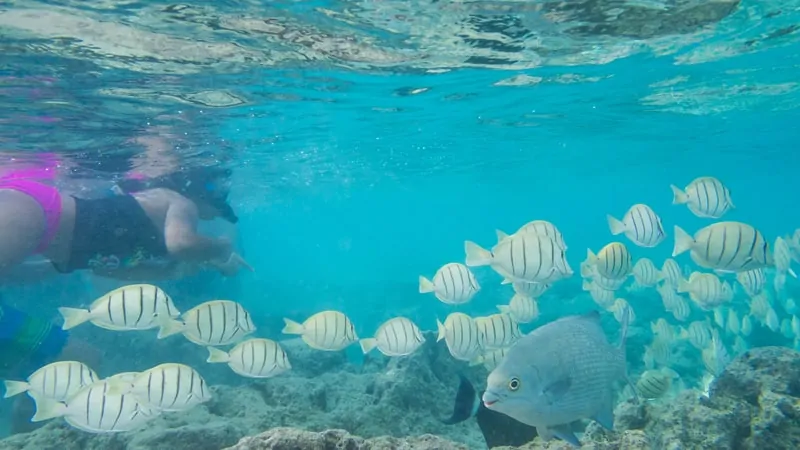
How To Get To Hanauma Bay
You can travel by rental car, shuttle, taxi or bus. The bay is easy to access, no matter where you stay on the island.
Because Hanauma Bay is a protected marine life conservation area, it’s designated as a nature preserve. It’s important to follow the rules, like not touching the marine life for example. Visitors take pictures and enjoy the scenery, but it’s strictly forbidden to remove anything. Make sure your kids are aware of this.
You’ll need to pay an entrance fee. Furthermore, everyone is required to watch a 10-minute video about the bay and its reef system. The video includes a little history and instructs to never feed or touch the marine life. After the video, there is a 5-minute walk towards the beach. The scenery is really incredible so bring your camera! You can rent lockers and snorkel gear. Make sure to bring your own towel.
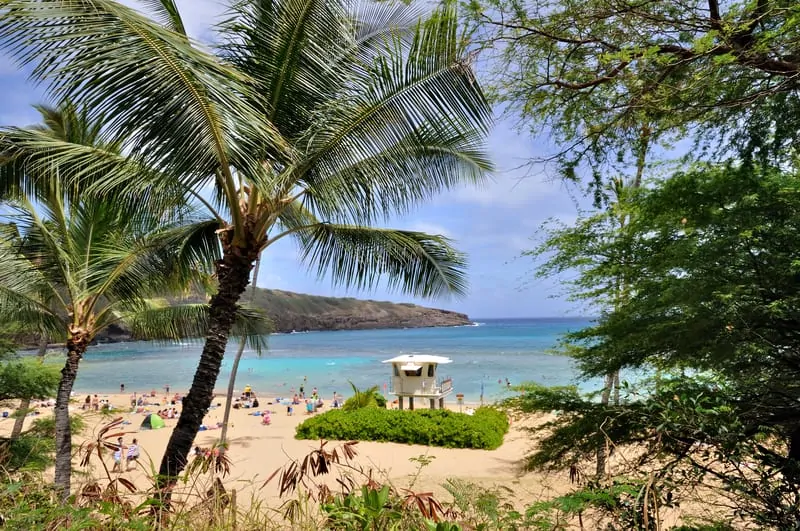
Snorkeling In The Bay
It’s easy to see the coral reef from the beach. The reef stretches in two directions, with a sandy center. We believe it’s a good idea to enter the sandy area and go from there. There aren’t many places to stop and stand once you’re floating above the coral.
The bay’s main attraction is its diverse marine life that lives and feeds on the reef. They are accustomed to snorkelers, so they won’t swim away and hide as fish often (logically) do. The water is crystal clear with great visibility. Furthermore, there are no strong currents near the shore.
There’s an outer and an inner reef. The inner reef is very safe in shallow calm waters. This is great for beginners! The center between the reefs is sandy and allows snorkelers to learn how to snorkel without any pressure or danger. The outer reef is for more advanced snorkelers as it’s closer to the edge of the bay. You’ll find larger fish and larger schools out there.
The reef in Hanauma Bay is pretty shallow. If you’re traveling with children, we advise you to also read our guide for snorkeling with kids.
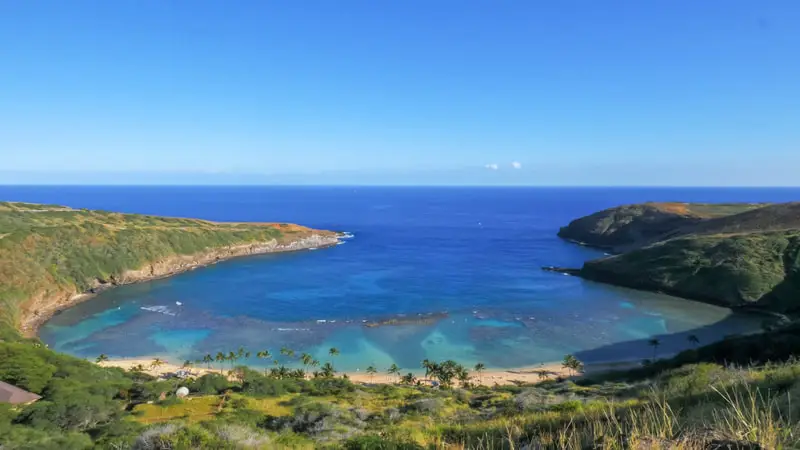
Marine Life In Hanauma Bay
Here’s a quick list of the marine life. More detailed information can be found in our Hawaiian fish guide.
Green Sea Turtles (3-4 feet in length)
Green sea turtles prefer the outer reef. They may swim right up to a snorkeler, but it’s illegal to touch or interfere with them. Green Sea Turtles are one of the most popular species within the bay.
Triggerfish (10 inches in length)
Triggerfish are always moving during the day, either alone or in small groups. They like the shallow areas of the reef.
Tang (8 inches in length)
Tang are territorial fish and usually travel in small schools. If you see them near a crevice, don’t bother them. There are about 80 different species of tang worldwide.
Surgeonfish (22 inches in length)
These herbivores feed on algae near rocks that receive a lot of filtered sunlight. They travel alone or in small schools.
Moray Eels (2 feet in length)
Keep an eye on Moray eels. They’re fascinating to observe as long as you leave them alone. Their sharp teeth can bite, so never stick your hands into rocky crevices (that’s where they often hide).
Butterfly Fish (6 inches in length)
Butterflyfish travel in schools and feed on coral polyps. They prefer shallow water, always looking for a food source.
Parrotfish (12 – 27 inches in length)
Parrotfish prefer to swim in shallow water as well. You can’t miss them because they’re usually very active.
Goatfish (21 inches)
Goatfish can swim in large schools with other fish, or they may swim alone.
Box Jellyfish (2 inches in length)
These jellyfish are common in Oahu. Their number increases 9 or 10 days after a full moon. Keep your distance because they can sting.
Sea Urchins (3.5 inches in length)
Sea Urchins have small little spikes all over their bodies. You may injure yourself if you step on one. Mind your step and wear water shoes.
Tip: We show more pictures of the actual marine life in our summary video, which you can find at the bottom of this article.
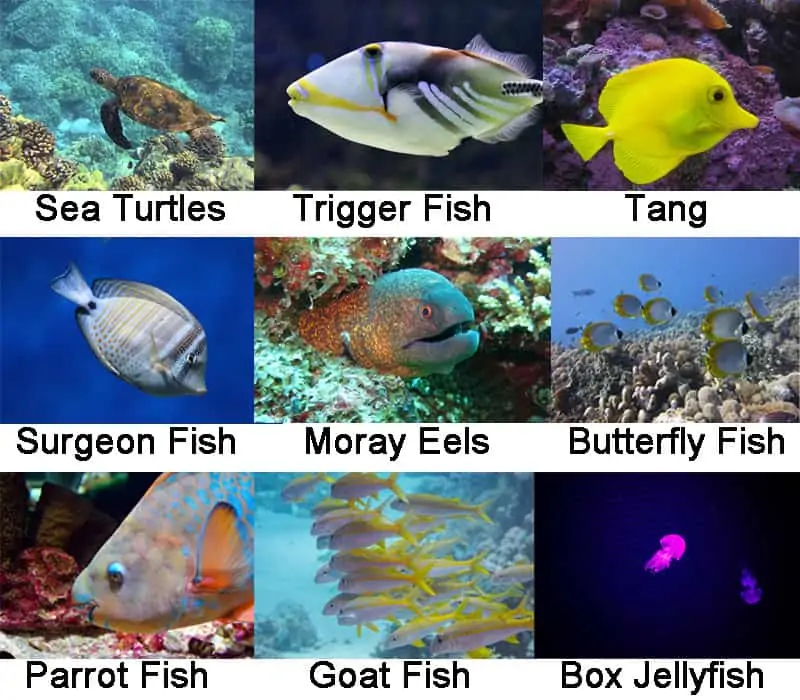
Coral
Yes, Hanauma Bay is home to a quite some coral. As we all know, coral attracts fish, which is why this bay is so “alive”. Just so you know, you’ll only find hard coral. Types of hard coral include lobe, blue rice and cauliflower.
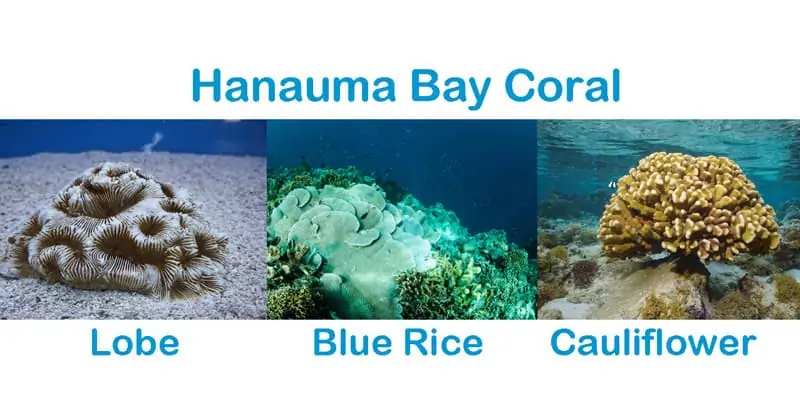
What Else To Do?
If you or one of your friends isn’t interested in snorkeling, don’t forget about the beach. The beach at Hanauma Bay is made of beautiful white sand. With palm trees in the background you should get those “tropical holiday feelings”.
Hanauma bay is a volcanic crater. You can actually see the Koko crater towards the north. This volcanic mountain is popular for hiking with its botanical gardens (there’s a trail you can follow). In addition, Hanauma Bay offers a nature park, grove trees, native plants native and picnic spots. Why not grill some lunch and play a game of volleyball on the grass court?
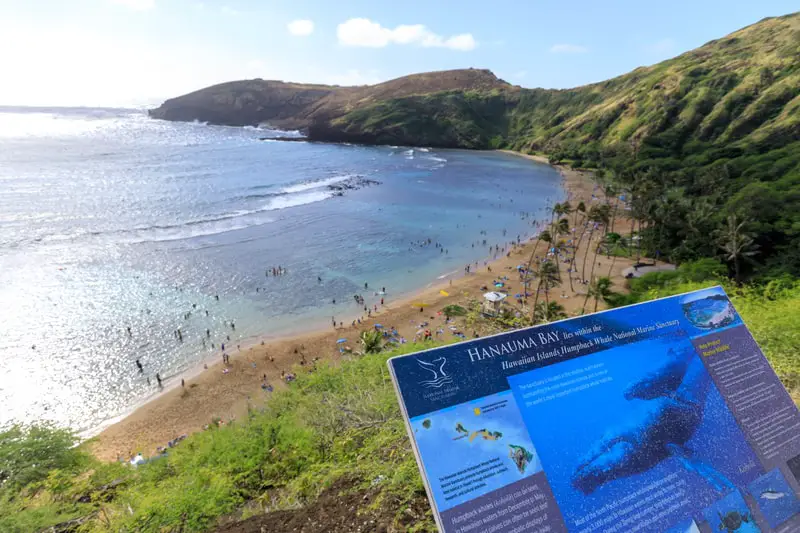
Hanauma Bay Climate
Temperature
Hanauma Bay is quite warm all year round. The hottest months last from July until October. That’s when the maximum temperature reaches around 84°F. In January, February and March the maximum temperature reaches approximately 77°F. Daylight hours reach their peaks in May, June and July.
Sea Temperature
The sea temperature is very enjoyable throughout the entire year. It fluctuates between 75°F (in March) and 81°F (in October). The summer months are slightly warmer than the winter months.
Rainfall
Rainy days occur throughout the year. However, if you take a look at the amount of rain, we can conclude that April until September shows the lowest amount of rain. Now, even though you can sometimes still snorkel in the rain, it’s always best to choose a sunny day when visibility is much better.
More detailed information about the climate can be found here.
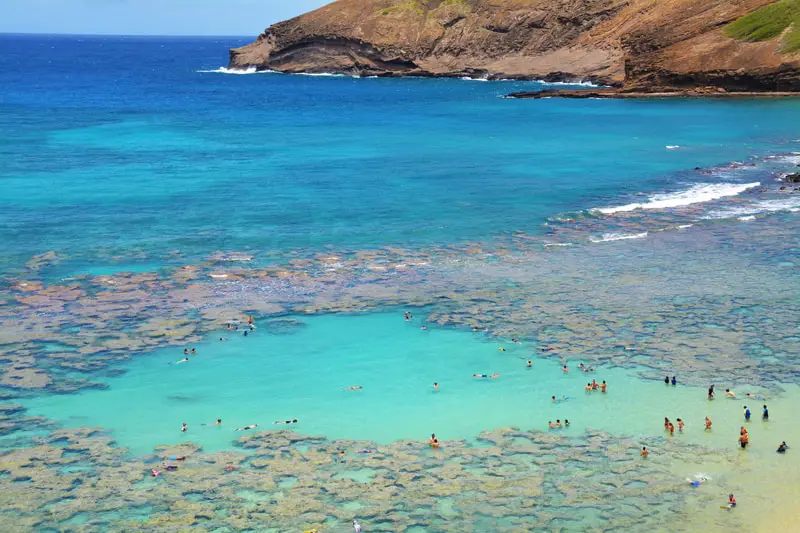
Final Thoughts
Hanauma Bay is a lovely and exciting snorkel location for both beginners and professionals. The marine life is very diverse. Thanks to the shallow water you’ll be able to observe everything up close. You’ll find sea turtles, trigger fish, parrot fish and many more. There are 3 types of hard coral.
If you ever make it to this wonderful paradise, we guess you won’t regret it. Furthermore, if you always wanted to try some underwater photography, this should be a great pick. You’ll be able to take some awesome close-up footage when snorkeling with a GoPro for example.
If you can, try to arrive on time because the amount of visitors is limited. Enjoy the beach, the green scenery and the magic underwater world. A true snorkelers dream if you ask us.

